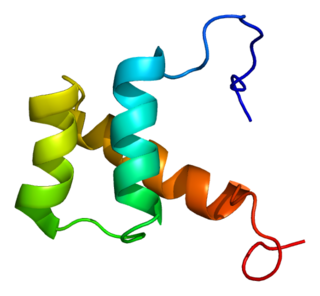Homeobox protein DLX-4 is a protein that in humans is encoded by the DLX4 gene. [5]
Homeobox protein DLX-4 is a protein that in humans is encoded by the DLX4 gene. [5]
Many vertebrate homeobox-containing genes have been identified on the basis of their sequence similarity with Drosophila developmental genes. Members of the Dlx gene family contain a homeobox that is related to that of Distal-less (Dll), a gene expressed in the head and limbs of the developing fruit fly. The Distal-less (Dlx) family of genes comprises at least 6 different members, DLX1-DLX6. The DLX proteins are postulated to play a role in forebrain and craniofacial development. Three transcript variants have been described for this gene, however, the full length nature of one variant has not been described. Studies of the two splice variants revealed that one encoded isoform (BP1) functions as a repressor of the beta-globin gene while the other isoform lacks that function. [5]
The epithelial–mesenchymal transition (EMT) is a process by which epithelial cells lose their cell polarity and cell–cell adhesion, and gain migratory and invasive properties to become mesenchymal stem cells; these are multipotent stromal cells that can differentiate into a variety of cell types. EMT is essential for numerous developmental processes including mesoderm formation and neural tube formation. EMT has also been shown to occur in wound healing, in organ fibrosis and in the initiation of metastasis in cancer progression.

The activin A receptor also known as ACVR1C or ALK-7 is a protein that in humans is encoded by the ACVR1C gene. ACVR1C is a type I receptor for the TGFB family of signaling molecules.
Genes in the DLX family encode homeodomain transcription factors related to the Drosophiladistal-less(Dll) gene. The family has been related to a number of developmental features such as jaws and limbs. The family seems to be well preserved across species. As DLX/Dll are involved in limb development in most of the major phyla, including vertebrates, it has been suggested that Dll was involved in appendage growth in an early bilaterial ancestor.

Homeobox protein CDX-2 is a protein that in humans is encoded by the CDX2 gene. The CDX2 protein is a homeobox transcription factor expressed in the nuclei of intestinal epithelial cells, playing an essential role in the development and function of the digestive system. CDX2 is part of the ParaHox gene cluster, a group of three highly conserved developmental genes present in most vertebrate species. Together with CDX1 and CDX4, CDX2 is one of three caudal-related genes in the human genome.

Homeobox protein MSX-2 is a protein that in humans is encoded by the MSX2 gene.

Laminin subunit beta-1 is a protein that in humans is encoded by the LAMB1 gene.

C-terminal-binding protein 2 also known as CtBP2 is a protein that in humans is encoded by the CTBP2 gene.

Homeobox protein DLX-5 is a protein that in humans is encoded by the distal-less homeobox 5 gene, or DLX5 gene. DLX5 is a member of the DLX gene family.

Homeobox protein DLX-3 is a protein that in humans is encoded by the DLX3 gene.

Homeobox protein Hox-C6 is a protein that in humans is encoded by the HOXC6 gene. Hox-C6 expression is highest in the fallopian tube and ovary. HoxC6 has been highly expressed in many types of cancers including prostate, breast, and esophageal squamous cell cancer.

Paired related homeobox 1 is a protein that in humans is encoded by the PRRX1 gene.

NEDD4-like E3 ubiquitin-protein ligase WWP2 also known as atrophin-1-interacting protein 2 (AIP2) or WW domain-containing protein 2 (WWP2) is an enzyme that in humans is encoded by the WWP2 gene.

Homeobox Protein HB24 is a protein that in humans is encoded by the HLX gene.

Homeobox protein MOX-2 is a protein that in humans is encoded by the MEOX2 gene.

Homeobox protein DLX-2 is a protein that in humans is encoded by the DLX2 gene.

Homeobox protein Meis2 is a protein that in humans is encoded by the MEIS2 gene.

Krueppel-like factor 8 is a protein that in humans is encoded by the KLF8 gene. KLF8 belongs to the family of KLF protein. KLF8 is activated by KLF1 along with KLF3 while KLF3 represses KLF8.

Homeobox protein DLX-1 is a protein that in humans is encoded by the DLX1 gene.

Homeobox protein MOX-1 is a protein that in humans is encoded by the MEOX1 gene.

Homeobox protein Hox-A2 is a protein that in humans is encoded by the HOXA2 gene.
This article incorporates text from the United States National Library of Medicine, which is in the public domain.